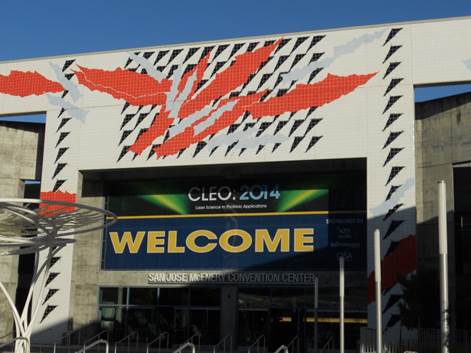CLEO 2014 Ryota Fushimi
Research
CLEO : 2014 Participation Report
Ryota Fushimi, 2nd year master's student, Tanabe Laboratory
He gave two poster presentations: one on all-optical logic gates ("Robustness of scalable all-optical logic gates") and the other on Q factor calculation by simulation of photonic crystal resonators ("Fast and accurate calculation of Q factor of 2D photonic crystal cavity"). ("Fast and accurate calculation of Q factor of 2D photonic crystal cavity"). In the presentation on logic gates, there were many questions about switching systems. The Q factor calculation was of particular interest to those who specialize in photonic crystals.

From here, I will introduce some of the presentations I attended that I found interesting, as well as presentations by researchers in fields close to my own laboratory.
1.JTu4A.92, M. minkov and V. savona, "Design-specific global optimization of a variety of photonic crystal cavities".
SM4M.2, Y.lai, et al, "L3 Photonic Crystal Nanocavities with Measured Q-factor Exceeding One Million".
The purpose of the algorithm for calculating the Q-value is the same, and although the method is difficult, it saves a tremendous amount of time, as well as optimization, creation, and measurement.
The first presentation was the optimization of structures such as L3 resonators using the fast Q-value acquisition method, and the highest theoretical Q-value was obtained. In a joint research with another group, the optimized structure was actually created, and the highest experimental Q value was obtained. These results have already been published in Nature Scientific reports.In the future, we would like to increase the speed of our research and produce results.
1.JTu4A.79, S. M. Lo, et al, "Photonic Crystal Microring Resonator based Sensors".
The photonic band gap is created by periodically opening vacancies in the microring like photonic crystals, which solves a common problem in sensor applications, i.e., that it is difficult to track shifts due to many standing modes, by limiting the number of modes. In addition, the surface area is greatly increased by opening the vacancies, enabling more sensitive sensing.
1.SM3G.1, J. K. Poon, et al, "Breaking the Conventional Limitations of Microrings".
In his research on logic gates, he has numerically shown that the resonance wavelength shift and coupling strength change caused by fabrication errors have a fatal effect on the system. This presentation describes a design to reduce the fabrication error and a modulation scheme that breaks the trade-off between bandwidth and modulation speed, which is always a problem in modulation using resonators. Specifically, the coupling between the ring and the waveguide is performed simultaneously in a straight line, and the waveguide width is increased when the ring curves, thereby reducing the effect on the internal modes for slight width blurring. The modulation method is not to change the resonance wavelength but to modulate the coupling strength.
As the gap between resonator research and industrial applications is becoming increasingly recognized, we hope to see more of this type of research.
1.FTh1K.5, H. Li and M. Li, "Torsional Cavity Optomechanical Nano-Seesaw System".
The beam has a seesaw-like structure with two nanobeam resonators, each supported by a single point. When the beam is tilted, the resonance wavelength changes and the state of the inside of the resonator also changes. In other words, it is a coupling of light and machine (optomechanics). Although the structure is interesting, this presentation classified how the optical and mechanical resonators are coupled, and this research was classified as an independent optical resonator coupled with a mechanical resonator. In the future, they plan to develop a structure in which mechanical resonators are connected to independent optical resonators arranged in arrays like nodes.
1.JTh5B.3, Y. Shen, et al, "Optical Broadband Angular Selectivity".
Wavelength-selective materials are all around us, including stained glass, and polarization-dependent materials include liquid crystals. Polarization-dependent sheets, however, have not been proposed until now. In this presentation, we use a well-known phenomenon called Brewster's angle to realize it. By designing the refractive index and thickness, we have created a sheet that can transmit only visible light at a certain angle of incidence. The theory is simple, but no one has thought of it before, and the research was published in Science. It was a reminder that interesting research still remains at the textbook level.
- Categories
- 国際会議報告


